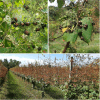Popillia japonica - Italian outbreak management
- PMID: 38469512
- PMCID: PMC10926379
- DOI: 10.3389/finsc.2023.1175138
Popillia japonica - Italian outbreak management
Abstract
Popillia japonica, a priority pest for the EU, was first detected in Northern Italy in 2014. Since its discovery, the outbreak extended over an area of more than 16,000 square kilometers in Northern Italy and Southern Switzerland. In this review, we summarize the state-of-the-art of research conducted in Italy on both the spreading capacity and control measures of P. japonica. Chemical, physical, and biological control measures deployed since its detection are presented, by highlighting their strengths and weaknesses. An in-depth study of the ecosystems invaded by P. japonica disclosed the presence and pathogenicity of natural strains of entomopathogenic fungi and nematodes, some of which have shown to be particularly aggressive towards the larvae of this pest under laboratory conditions. The Plant Health authorities of the Lombardy and Piedmont regions, with the support of several research institutions, played a crucial role in the initial eradication attempt and subsequently in containing the spread of P. japonica. Control measures were performed in the infested area to suppress adult populations of P. japonica by installing several traps (e.g., for mass trapping, for auto-dissemination of the fungus Metarhizium anisopliae, and "attract & kill"). For larval control, the infested fields were treated with commercial strains of the entomopathogenic fungus M. anisopliae and nematode Heterorhabditis bacteriophora. Future studies will aim at integrating phenological and spread models developed with the most effective control measures, within an ecologically sustainable approach.
Keywords: EU priority pest; Japanese beetle; biological control agents; biological invasion; chemical control; pest management; spatial analysis.
Copyright © 2023 Gotta, Ciampitti, Cavagna, Bosio, Gilioli, Alma, Battisti, Mori, Mazza, Torrini, Paoli, Santoiemma, Simonetto, Lessio, Sperandio, Giacometto, Bianchi, Roversi and Marianelli.
Conflict of interest statement
The authors GT and LM declared that they were an editorial board member of Frontiers, at the time of submission. This had no impact on the peer review process and the final decision. The remaining authors declare that the research was conducted in the absence of any commercial or financial relationships that could be construed as a potential conflict of interest. The reviewer J-CG declared a past co-authorship with the authors AB and GG to the handling Editor.
Figures







References
-
- Fleming WE. Biology of the Japanese beetle (Technical bulletin no. 1449). Washington DC: US Department of Agriculture; (1972).
-
- Lessio F, Pisa CG, Picciau L, Ciampitti M, Cavagna B, Alma A. An immunomarking method to investigate the flight distance of the Japanese beetle. Entomol Gen (2022) 42(1):45–56. doi: 10.1127/entomologia/2021/1117 - DOI
-
- Althoff ER, Rice KB. Japanese Beetle (Coleoptera: scarabaeidae) invasion of north America: history, ecology, and management. J Integr Pest Manage (2022) 13(1):2. doi: 10.1093/jipm/pmab043 - DOI
Publication types
LinkOut - more resources
Full Text Sources

